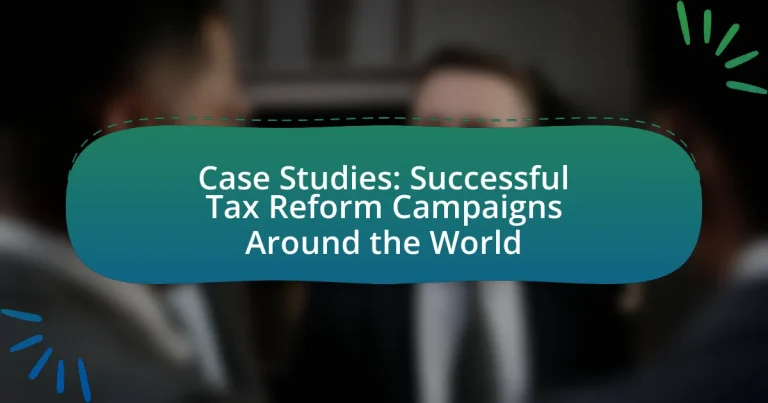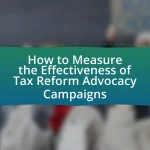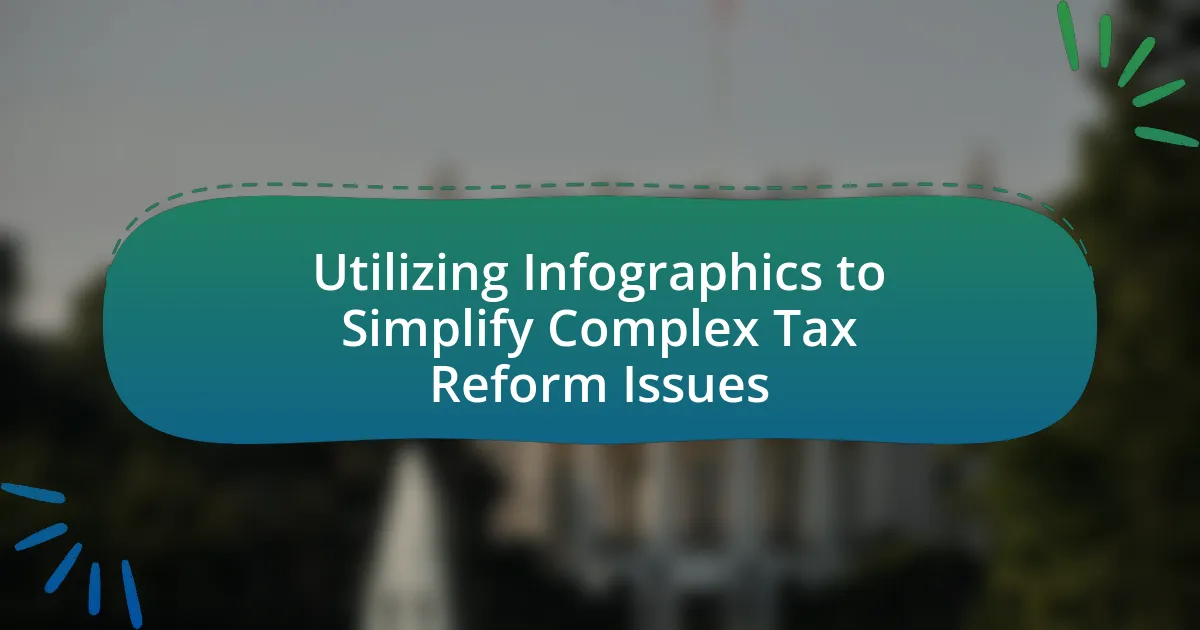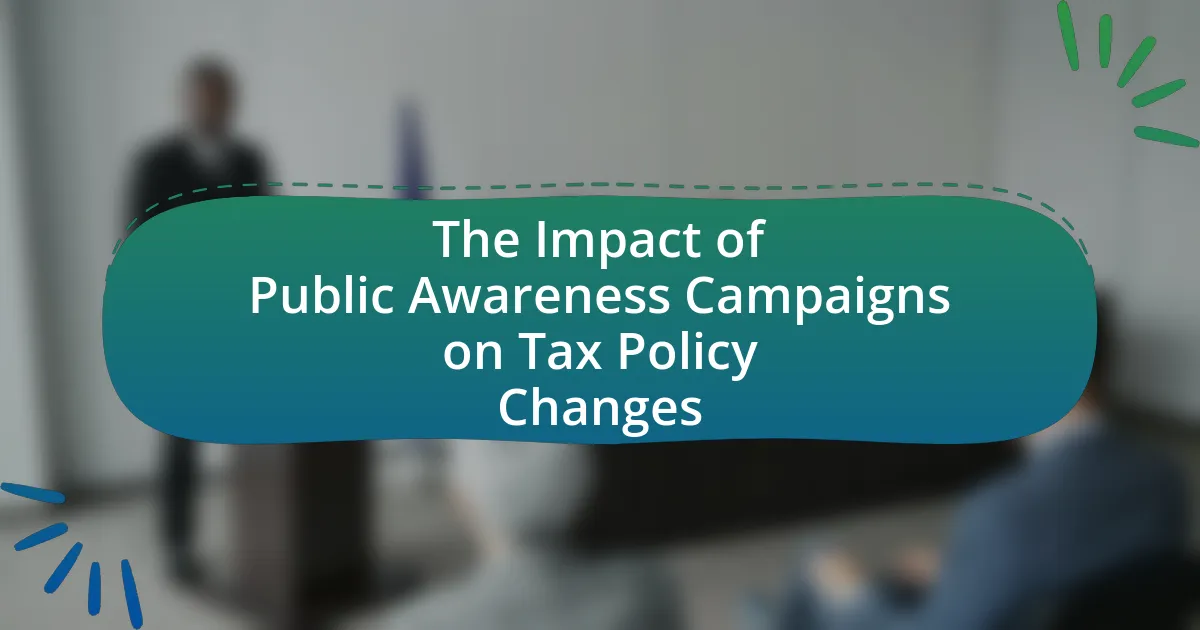The article focuses on successful tax reform campaigns worldwide, examining how these initiatives effectively alter tax policies to enhance economic efficiency, equity, and revenue generation. It highlights key factors contributing to the success of these campaigns, such as strong public support, clear communication, and coalition-building among stakeholders. The article also explores the differences in tax reform approaches across various countries, the significance of case studies in understanding tax reform, and the roles of governments, businesses, and citizens in these efforts. Notable examples, including the 2017 U.S. Tax Cuts and Jobs Act and reforms in Sweden and New Zealand, illustrate effective strategies and outcomes, providing insights for future tax policy formulation.
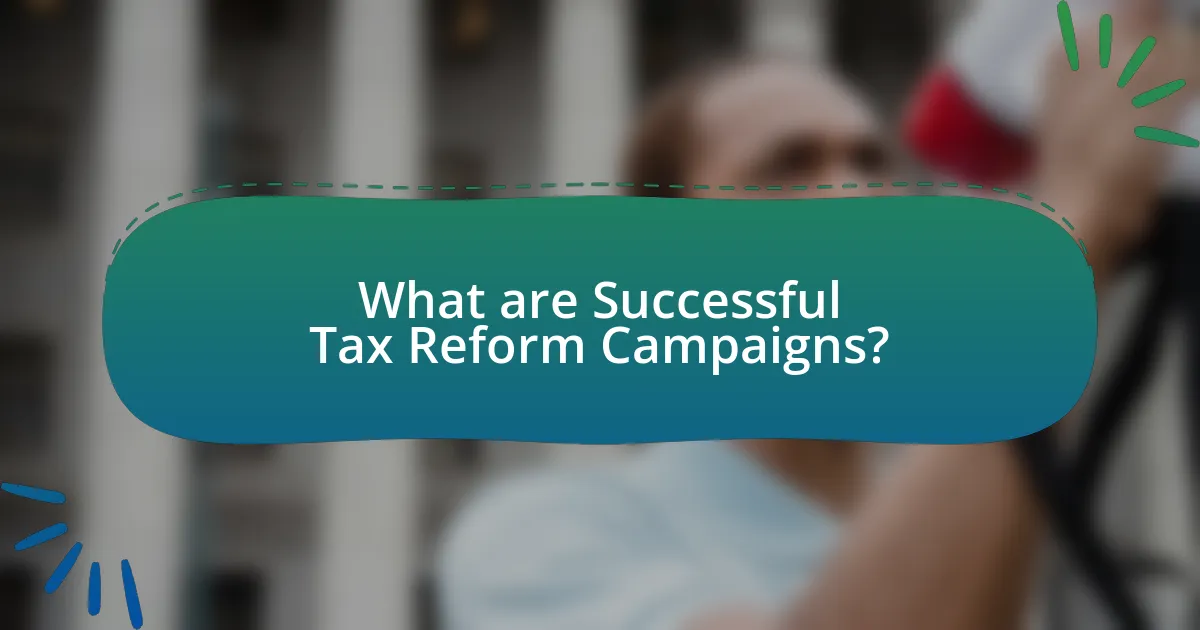
What are Successful Tax Reform Campaigns?
Successful tax reform campaigns are initiatives that effectively change tax policies to improve economic efficiency, equity, and revenue generation. These campaigns often involve comprehensive strategies that include stakeholder engagement, clear communication of benefits, and evidence-based proposals. For instance, the 2017 Tax Cuts and Jobs Act in the United States aimed to stimulate economic growth by reducing corporate tax rates and simplifying the tax code, resulting in a significant increase in GDP growth in subsequent years. Additionally, successful campaigns typically demonstrate measurable outcomes, such as increased compliance rates or enhanced public services funded by the reformed tax system, validating their effectiveness.
How do tax reform campaigns differ across countries?
Tax reform campaigns differ across countries primarily due to variations in political systems, economic conditions, and public attitudes toward taxation. For instance, in Scandinavian countries, tax reform campaigns often emphasize social equity and welfare funding, leading to broad public support for higher taxes. In contrast, in the United States, tax reform campaigns frequently focus on reducing tax burdens and promoting economic growth, reflecting a more individualistic approach to taxation. Additionally, countries like Germany engage in extensive stakeholder consultations before implementing reforms, while others may adopt more top-down approaches, as seen in some developing nations where reforms are often driven by international financial institutions. These differences highlight how cultural, economic, and political contexts shape the strategies and outcomes of tax reform initiatives globally.
What factors contribute to the success of tax reform campaigns?
Successful tax reform campaigns are primarily influenced by strong public support, clear communication of benefits, and effective coalition-building among stakeholders. Public support is crucial, as demonstrated in the 2017 U.S. tax reform, where grassroots movements mobilized citizens to advocate for changes. Clear communication of the benefits, such as economic growth and fairness, helps to gain wider acceptance; for instance, in Sweden, the government effectively communicated the advantages of tax reforms, leading to increased compliance and support. Additionally, coalition-building among businesses, advocacy groups, and political leaders can create a unified front, as seen in New Zealand’s tax reforms in the 1980s, where collaboration among diverse stakeholders facilitated successful implementation. These factors collectively enhance the likelihood of achieving successful tax reform outcomes.
How do political, economic, and social contexts influence tax reform?
Political, economic, and social contexts significantly influence tax reform by shaping the priorities, feasibility, and public support for changes in tax policy. Political contexts, such as the governing party’s ideology and the composition of legislative bodies, determine the likelihood of enacting reforms; for instance, a government with a strong mandate may pursue aggressive tax changes, while a divided legislature may stall reforms. Economic contexts, including the state of the economy and fiscal pressures, drive the need for tax reform; during economic downturns, governments may seek to increase revenue through tax changes to address budget deficits. Social contexts, such as public opinion and demographic factors, affect the acceptance of tax reforms; for example, reforms that are perceived as equitable may gain broader support, while those seen as favoring the wealthy may face backlash. Historical examples, such as the 2017 U.S. Tax Cuts and Jobs Act, illustrate how these contexts interact, as the political majority pushed for tax cuts amid a growing economy, while public sentiment influenced the specifics of the reform.
Why are case studies important for understanding tax reform?
Case studies are important for understanding tax reform because they provide real-world examples of how tax policies are implemented and their effects on various stakeholders. By analyzing specific instances of tax reform, researchers and policymakers can identify successful strategies and potential pitfalls, allowing for more informed decision-making. For example, the tax reform in Sweden during the 1990s, which included broadening the tax base and lowering rates, resulted in increased economic growth and improved public services, demonstrating the effectiveness of certain reform approaches. Such concrete examples help to illustrate the complexities of tax systems and the diverse outcomes that can arise from different reform efforts.
What insights can be gained from analyzing successful tax reform campaigns?
Analyzing successful tax reform campaigns reveals key insights into effective strategies and stakeholder engagement. Successful campaigns often emphasize clear communication of the reform’s benefits, as seen in the 2017 U.S. Tax Cuts and Jobs Act, which highlighted tax relief for middle-class families. Additionally, building broad coalitions among diverse interest groups, such as businesses and community organizations, enhances support, exemplified by the 2012 tax reform in Chile that involved extensive stakeholder consultations. Furthermore, successful campaigns utilize data-driven approaches to demonstrate the economic impact of reforms, as evidenced by the 2014 tax reform in Estonia, which showcased increased investment and growth metrics post-reform. These insights underscore the importance of transparency, coalition-building, and empirical evidence in driving successful tax reform initiatives.
How do case studies help in formulating future tax policies?
Case studies help in formulating future tax policies by providing empirical evidence of the outcomes and impacts of previous tax reforms. They allow policymakers to analyze specific instances where tax policies were implemented, assessing both successes and failures. For example, the case study of the 2012 tax reform in Estonia demonstrated how a flat tax rate can stimulate economic growth and increase compliance, leading to a broader tax base. This evidence informs future policy decisions by highlighting effective strategies and potential pitfalls, enabling a more informed approach to tax reform.
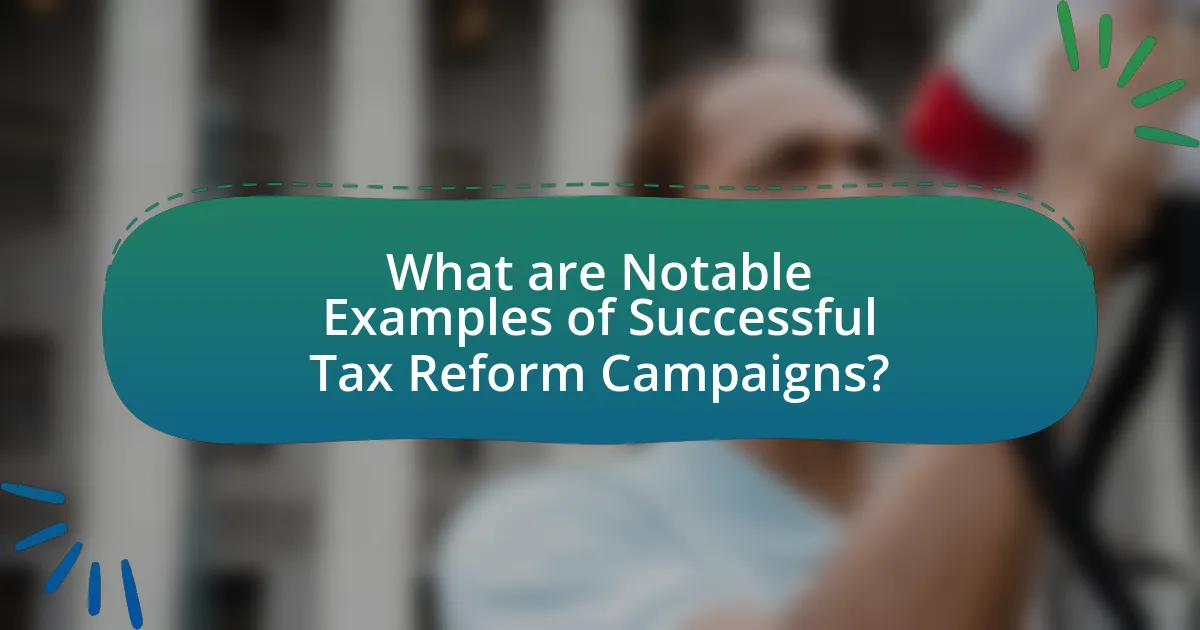
What are Notable Examples of Successful Tax Reform Campaigns?
Notable examples of successful tax reform campaigns include the 1986 Tax Reform Act in the United States and the 2012 tax reform in Japan. The 1986 Tax Reform Act simplified the tax code by reducing the number of tax brackets and eliminating many deductions, resulting in a broader tax base and increased revenue. This reform was supported by bipartisan efforts and aimed to make the tax system fairer and more efficient. In Japan, the 2012 tax reform aimed to increase the consumption tax from 5% to 8%, which was part of a broader strategy to address fiscal challenges and promote economic stability. This reform was implemented with public awareness campaigns to explain the necessity of the tax increase for social security funding. Both examples demonstrate effective strategies in tax reform that led to significant changes in their respective countries’ fiscal policies.
Which countries have implemented successful tax reforms?
Countries that have implemented successful tax reforms include Sweden, which restructured its tax system in the 1990s to enhance efficiency and equity, resulting in increased revenue and economic growth. Another example is New Zealand, which undertook significant tax reforms in the 1980s, simplifying the tax code and broadening the tax base, leading to improved compliance and economic performance. Additionally, Germany’s tax reforms in the early 2000s focused on reducing corporate tax rates and improving investment incentives, contributing to economic recovery and growth. These examples demonstrate effective tax reform strategies that have positively impacted economic outcomes.
What were the key strategies used in these successful campaigns?
The key strategies used in successful tax reform campaigns included comprehensive stakeholder engagement, clear communication of benefits, and data-driven advocacy. Comprehensive stakeholder engagement involved collaborating with various groups, including businesses, taxpayers, and policymakers, to build a coalition that supported the reform. Clear communication of benefits ensured that the public understood how the reforms would positively impact their lives, often highlighting tax reductions or improved public services. Data-driven advocacy utilized empirical evidence and case studies to demonstrate the effectiveness of proposed reforms, thereby gaining credibility and support from both the public and decision-makers. These strategies were evident in campaigns such as the 2017 U.S. Tax Cuts and Jobs Act, which effectively combined these elements to achieve legislative success.
How did public opinion shape the outcomes of these reforms?
Public opinion significantly influenced the outcomes of tax reform campaigns by driving political agendas and shaping legislative priorities. For instance, in countries like New Zealand and Sweden, widespread public support for tax reforms led to the implementation of more equitable tax systems, as politicians recognized the need to align their policies with the electorate’s preferences. In New Zealand, the 1984 tax reforms were largely a response to public demand for economic stability and fairness, resulting in a shift towards a more progressive tax structure. Similarly, in Sweden, public backing for welfare state funding prompted reforms that increased tax rates on higher incomes, reflecting the populace’s desire for enhanced social services. These examples illustrate how public sentiment can compel policymakers to adopt reforms that resonate with the values and needs of their constituents.
What lessons can be learned from these case studies?
Successful tax reform campaigns demonstrate the importance of stakeholder engagement, clear communication, and data-driven decision-making. Engaging stakeholders, including taxpayers and businesses, fosters trust and collaboration, as seen in the successful tax reforms in countries like New Zealand and Sweden. Clear communication of the benefits and rationale behind tax reforms helps to mitigate resistance and build public support, evidenced by the transparency in the tax reform processes in Canada. Data-driven decision-making ensures that reforms are based on empirical evidence, which enhances their effectiveness and sustainability, as illustrated by the reforms in Estonia that utilized comprehensive economic analysis. These lessons highlight the critical components necessary for successful tax reform implementation.
How can these lessons be applied to future tax reform efforts?
Lessons from successful tax reform campaigns can be applied to future efforts by emphasizing the importance of stakeholder engagement and clear communication. For instance, the successful tax reforms in countries like Sweden and New Zealand involved extensive consultations with various stakeholders, including businesses and citizens, which fostered trust and buy-in. Additionally, these campaigns effectively communicated the benefits of reform, such as improved public services and economic growth, which helped to mitigate resistance. Historical data shows that reforms with strong public support tend to be more sustainable, as seen in the 1986 Tax Reform Act in the United States, which was backed by a broad coalition of interests. Thus, future tax reform efforts should prioritize inclusive dialogue and transparent messaging to enhance acceptance and implementation.
What common challenges did these campaigns face?
Successful tax reform campaigns commonly faced challenges such as public resistance, political opposition, and implementation complexities. Public resistance often stemmed from a lack of understanding or fear of the implications of tax changes, as seen in campaigns like the 2012 tax reform in France, where widespread protests occurred. Political opposition frequently arose from differing party agendas, complicating consensus-building, exemplified by the challenges faced during the 2017 tax reform in the United States, where partisan divides hindered swift passage. Implementation complexities included logistical issues in executing new tax systems, which were evident in the rollout of the Goods and Services Tax in India in 2017, where businesses struggled to adapt to the new framework.
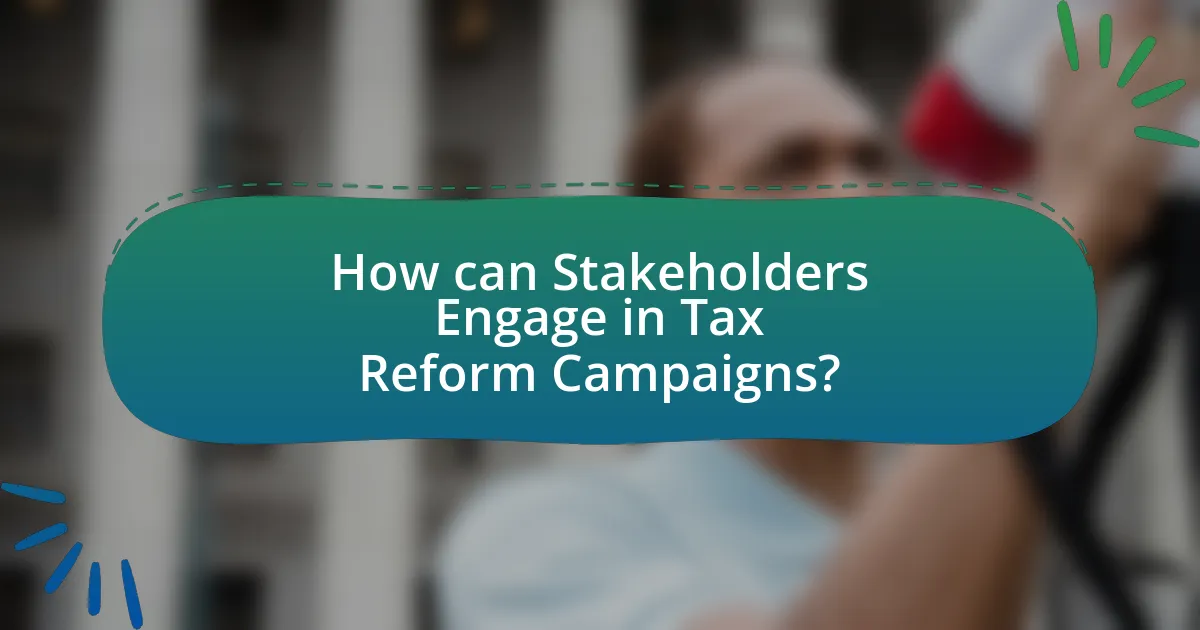
How can Stakeholders Engage in Tax Reform Campaigns?
Stakeholders can engage in tax reform campaigns by forming coalitions, advocating for policy changes, and mobilizing public support. For instance, coalitions of businesses, non-profits, and community organizations can pool resources and expertise to influence legislative processes effectively. Advocacy efforts can include lobbying government officials, participating in public hearings, and submitting policy proposals that reflect the interests of diverse groups. Mobilizing public support through awareness campaigns, social media outreach, and grassroots organizing can amplify the message and pressure policymakers to consider reform. Historical examples, such as the successful tax reform initiatives in countries like New Zealand and Sweden, demonstrate that coordinated stakeholder engagement can lead to significant changes in tax policy.
What roles do governments, businesses, and citizens play in tax reform?
Governments, businesses, and citizens each play crucial roles in tax reform. Governments are responsible for creating and implementing tax policies, ensuring they align with economic goals and social equity. For instance, in countries like Sweden, the government has successfully reformed tax systems to enhance efficiency and fairness, leading to increased public trust and compliance. Businesses contribute by advocating for tax policies that promote economic growth and competitiveness; they often engage in lobbying efforts to influence tax legislation. For example, the U.S. Chamber of Commerce has historically pushed for tax reforms that benefit the business sector. Citizens participate by voicing their opinions and voting on tax-related issues, which can shape public policy; grassroots movements have been pivotal in tax reform initiatives, as seen in various local campaigns across the globe. Together, these entities create a dynamic interplay that drives effective tax reform.
How can collaboration among stakeholders enhance tax reform efforts?
Collaboration among stakeholders can significantly enhance tax reform efforts by fostering a comprehensive understanding of diverse perspectives and needs. When government entities, businesses, civil society, and citizens work together, they can identify common goals and create tax policies that are equitable and effective. For instance, the successful tax reform in New Zealand in the 1980s involved collaboration between the government and various interest groups, leading to a more streamlined tax system that improved compliance and revenue collection. This collaborative approach not only facilitated the sharing of valuable insights but also built trust among stakeholders, which is crucial for the long-term sustainability of tax reforms.
What strategies can stakeholders use to advocate for successful tax reforms?
Stakeholders can advocate for successful tax reforms by employing strategies such as building coalitions, engaging in public education campaigns, and utilizing data-driven advocacy. Building coalitions among diverse groups, including businesses, non-profits, and community organizations, enhances credibility and amplifies voices in support of reform. Public education campaigns raise awareness about the benefits of tax reforms, helping to shift public opinion and garner support from constituents. Utilizing data-driven advocacy involves presenting empirical evidence and case studies that demonstrate the positive impacts of proposed reforms, which can persuade policymakers and stakeholders of their necessity. For instance, the successful tax reform in New Zealand in the late 1980s was driven by a coalition of business leaders and economists who effectively communicated the need for change through comprehensive data analysis and public engagement.
What best practices should be followed in tax reform campaigns?
Best practices in tax reform campaigns include clear communication, stakeholder engagement, and evidence-based policy proposals. Clear communication ensures that the objectives and benefits of the reform are understood by the public, which is crucial for gaining support. Stakeholder engagement involves consulting with various groups, including taxpayers, businesses, and advocacy organizations, to gather input and build consensus. Evidence-based policy proposals rely on data and research to justify changes, demonstrating their potential economic impact and fairness. For instance, the successful tax reform in New Zealand during the 1980s utilized these practices by involving stakeholders and presenting data-driven arguments, leading to widespread acceptance and implementation.
How can effective communication strategies improve public support for tax reforms?
Effective communication strategies can significantly enhance public support for tax reforms by clearly articulating the benefits and rationale behind the changes. When governments or organizations utilize transparent messaging, they can demystify complex tax policies, making them more relatable and understandable to the general public. For instance, a study by the Pew Research Center found that 70% of individuals are more likely to support tax reforms when they perceive a direct benefit to their community, such as improved public services or infrastructure. By employing targeted outreach, utilizing social media platforms, and engaging in community discussions, stakeholders can foster trust and address concerns, ultimately leading to greater acceptance and support for tax reforms.
What are the key metrics for measuring the success of tax reform campaigns?
Key metrics for measuring the success of tax reform campaigns include changes in tax revenue, public approval ratings, compliance rates, and economic growth indicators. Tax revenue is a primary metric, as successful reforms should ideally increase government income without significantly burdening taxpayers. Public approval ratings gauge citizen support for the reforms, reflecting their perceived fairness and effectiveness. Compliance rates indicate how well taxpayers adhere to new tax laws, which is crucial for assessing the reforms’ practicality. Economic growth indicators, such as GDP growth and job creation, provide insight into the broader impact of tax reforms on the economy. These metrics collectively offer a comprehensive view of the effectiveness and acceptance of tax reform initiatives.
What are the common pitfalls to avoid in tax reform campaigns?
Common pitfalls to avoid in tax reform campaigns include lack of clear communication, insufficient stakeholder engagement, and failure to address equity concerns. Clear communication is essential; without it, misinformation can spread, undermining public support. Insufficient engagement with stakeholders, such as businesses and community groups, can lead to resistance and missed opportunities for collaboration. Additionally, failing to address equity concerns can alienate vulnerable populations, as seen in various reform efforts where inequitable impacts led to public backlash. For instance, the 2017 U.S. tax reform faced criticism for disproportionately benefiting higher-income individuals, highlighting the importance of considering equity in tax policy design.
How can miscommunication hinder the success of tax reform efforts?
Miscommunication can significantly hinder the success of tax reform efforts by creating misunderstandings between policymakers and the public. When tax reform proposals are not clearly communicated, citizens may misinterpret the implications, leading to resistance or lack of support. For instance, a study by the National Bureau of Economic Research found that clear communication of tax policy changes can increase public acceptance and compliance, while vague messaging often results in confusion and skepticism. This confusion can stall legislative processes and diminish the effectiveness of reforms, as seen in various historical tax reform initiatives where public backlash stemmed from misinterpretation of the proposed changes.
What strategies can mitigate resistance to tax reforms?
Effective strategies to mitigate resistance to tax reforms include comprehensive stakeholder engagement, transparent communication, and phased implementation. Engaging stakeholders, such as businesses and community leaders, fosters collaboration and addresses concerns, as seen in the successful tax reforms in New Zealand during the 1980s, where extensive consultations led to broader acceptance. Transparent communication about the benefits and rationale behind reforms helps build public trust; for instance, in Sweden, clear messaging about how tax revenues fund public services has garnered support for tax changes. Phased implementation allows for gradual adjustment, reducing shock and resistance, exemplified by the gradual rollout of the Goods and Services Tax in Canada, which minimized backlash by allowing time for adaptation.
What practical tips can ensure the success of future tax reform campaigns?
To ensure the success of future tax reform campaigns, it is essential to engage stakeholders early and maintain transparent communication throughout the process. Engaging stakeholders, including taxpayers, businesses, and advocacy groups, fosters trust and encourages collaboration, which is critical for garnering support. For instance, the successful tax reform in New Zealand in the late 1980s involved extensive consultations with various stakeholders, leading to a more widely accepted reform package. Additionally, utilizing data-driven analysis to demonstrate the economic benefits of proposed reforms can effectively persuade both the public and policymakers. Research from the International Monetary Fund highlights that reforms backed by empirical evidence are more likely to gain traction and succeed.
